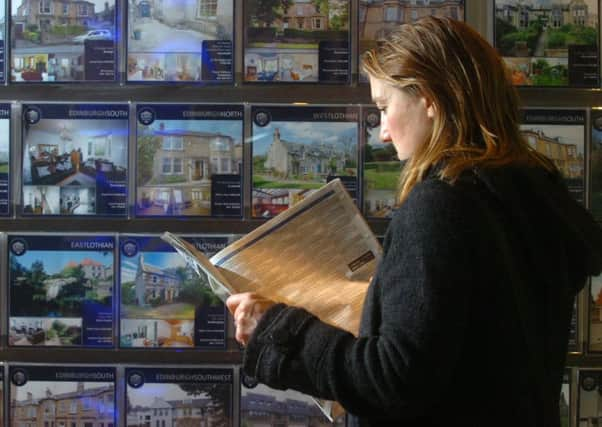First time Scottish house buyers face £21k hurdle


The study by Halifax found the average deposit is £21,565, typically around 16 per cent of the purchase price.
Those buying their first home make up nearly half of all house purchases financed by a mortgage across the UK, the bank said.
Advertisement
Hide AdAdvertisement
Hide AdIt said its figures showed the market was returning to a level of buoyancy not seen since the financial crash in 2007-8.
However, Scottish Labour warned young people are being priced out by the need for large deposits and the cost of renting.
Across the UK as a whole, an average deposit of £33,000 is needed, although the figure rises to more than £100,000 in London, according to the Halifax First-Time Buyer Review.
But the average price paid for a first home is at a record high of £207,693, Halifax found.
The average first-time buyer deposit put down in the first six months of 2017 was £32,899 – equating to 16 per cent of the purchase price.
In London, first-time buyers need to put together a deposit of £106,577 typically, or 26 per cent of the average price of a home.
First-time buyers in Northern Ireland put down the lowest deposits in cash terms on average, at £16,457.
Across the UK, the number of first-time buyers reached an estimated 162,704 in the first six months of 2017, only 15 per cent below a peak seen in the last boom in 2006, Halifax said.
Advertisement
Hide AdAdvertisement
Hide AdSchemes such as Help to Buy, combined with low mortgage rates, have given aspiring home owners a helping hand in recent years.
Martin Ellis, a housing economist at Halifax, said that for the third time in four years the numbers getting on the housing ladder in the first half of the year have exceeded 150,000 – “a level of momentum not seen since before the financial crisis”.
He said: “High levels of employment, low mortgage rates and government schemes such as Help to Buy have also helped these numbers remain robust.”
But Scottish Labour’s housing spokeswoman Pauline McNeill said more housebuilding was needed to make buying a home more affordable for young families.
“These figures show how hard it is for young people to get on the housing ladder,” she said. “Young people stuck in expensive private rents will struggle to save up for a deposit this high.
“The issue here is with supply – we need a more extensive housebuilding programme so everybody has the opportunity of a home, not just a roof over their heads.”
As well as the rising cost of rent, the average graduate leaves university in Scotland with around £11,000 of debt, according to figures published last year by Audit Scotland.
Despite concerns over the amount needed for a deposit, the proportion of first-time buyers has grown from 44 per cent to 47 per cent since the launch of Help to Buy in 2013.
Advertisement
Hide AdAdvertisement
Hide AdThere are also signs of first-time buyers stretching their loans beyond the traditional 25-year term, to cover higher house prices. In 2016, 56 per cent of their mortgage terms were for 25 to 35 years.
In 2007 just over a third (38 per cent) of first-time buyer mortgages were for between 25 and 35 years, Halifax said.
The least affordable area for first-time buyers was identified as Brent in London. A typical first-time buyer home there costs £459,499 or around 12.5 times local average earnings.
Stirling was identified as the most affordable place for first-time buyers, with a home there costing around £136,181 or around 2.9 times local average earnings.
Halifax used figures from the Council of Mortgage Lenders (CML) and the Office for National Statistics (ONS) for the research.
In Scotland, buyers of properties up to £145,000 pay no land and buildings transaction tax, which is £20,000 above the level which applies to UK stamp duty land tax.
Scottish housing minister Kevin Stewart said: “We are giving targeted help to those seeking to move into home ownership. Our open mark shared equity scheme, with a budget of £70 million this year, targets first-time buyers and priority access groups. Over the past decade it has helped more than 8,700 people on low to moderate incomes to buy a home.
“Our land and buildings transaction tax is also aimed at helping first-time buyers.”
Advertisement
Hide AdAdvertisement
Hide AdHe added: “Our commitment to deliver 50,000 more affordable homes over the next five years – with 35,000 available for social rent – will contribute to increasing the availability of affordable homes across Scotland.”